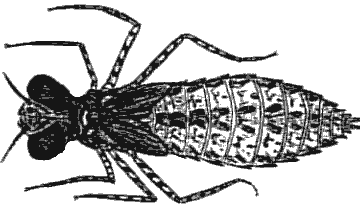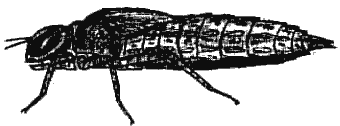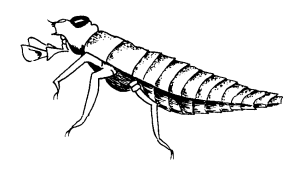 DRAGONFLIES DRAGONFLIES
article
by Ron Newman
Scientific
Name:
Class
- Insecta, Order - Odonata, Suborder - Anisoptera, Family
- Aeshnidae
Common
Names:
Dragonflies,
Darners, Gomphus, Skimmers

General:
Not to be
mistaken for it's cousin the damselfly, the adult dragonfly cannot fold
its wings along it's back. Dragonflies are usually much bigger and thicker
bodied than damselflies. Both are very predacious in both the nymph and
adult stage. Nymphs will feed on almost any creature in the lake including
very small fish.
Most of our
Interior dragonflies are 'Darners' of the family Aeshnidae. I have seen
a few 'Gomphus' dragonflies of the family Gomphinae and some Common Red
Skimmers but not enough to include as a major component of the following
discussion. Gomphus are also known as 'Clubtails' and the adults generally
have a distinctive club-like shape at the end of the tail. The Red Skimmers
are smaller than many of our regular dragonflies and adults have a definite
reddish color.
Life Cycle:
Adults mate
in flight and can often be seen flying in tandem. The fertilized female
'oviposites' her eggs into woody vegetation or in some cases over open
water or burrowed into the lake bottom. Metamorphosis is incomplete and
when the eggs hatch they are just a smaller version of later stages. Therefore,
all non-adult versions are simply referred to as nymphs. These nymphs
live and grow in the lake and molt their shells 10 to 12 times before
they are ready to hatch into adults. The nymphs crawl onto the shore or
shore line vegetation to hatch into adults. The adults live for a few
weeks to several months before mating. Most of our local dragonflies take
one to two years to complete a generation but this can be as long as four
years. This longer life cycle requires that most hibernate in the lakes
during the winter months. Hibernation is usually done in the deeper water
and this brings about spring and fall migrations to and from the shallow
waters.
 Appearance: Appearance:
Dragonfly
nymphs have large bulbous eyes and generally have a thick, cigar shaped
body. In cross section, the abdomen is somewhat triangular shaped, being
flat on the bottom and slightly ridged on the top. The legs of a dragonfly
nymph are fairly pronounced in comparison to most other aquatics. Dragonflies
do not go through a pupa stage. The immature forms look much the same
but are just different in size. Adults develop two pair of wings and the
abdomen lengthens and narrows for flight.
Size:
Many Darner
nymphs get up to 40 mm in length (1.5 inches) when ready to hatch into
adults. Broods of all sizes less than that will be in a lake.
Colour:
Shades of
black and light green are the two most common colors for dragonfly nymphs
in our lakes. However, they do come in other colors including darker greens,
grays, and a reddish brown.
 Movement: Movement:
Dragonfly
nymphs mostly crawl along weeds or the lake bottom in search of prey.
However, when disturbed or otherwise in a hurry, they can use a "jet propulsion"
system to rapidly propel themselves. The nymphs have internal gills for
which water is sucked into the body and then expelled. This expulsion
can be quite rapid to provide an emergency means of locomotion.
Habitat:
Since they
are highly predacious, the dragonfly nymphs will stay near available food
sources. These are generally found on the shoals or the shoal drop-offs
into deeper water. When not feeding they tend to hide under submerged
logs and rocks or among the bottom vegetation. They usually prefer pollution
free water that is well oxygenated but certain species will live in the
more stagnant ponds.
 Importance
to Fly Fishing: Importance
to Fly Fishing:
Dragonflies
are the fourth most important source of food for trout in the Interior
lakes. They comprise about 7% of the total feeding samples examined. For
dragonflies I haven't found a significant difference between feeding samples
of those fish caught during the day to those caught in the evening or
darkness hours.
The feeding
samples at 7% are somewhat misleading. Dragonflies are good at hiding
and staying out of reach from the feeding trout. If it can find a dragonfly,
the trout will often take it in preference to many other available foods.
Likely this is because of the its large size. One dragonfly nymph ready
to hatch is equivalent to about 25 Chironomid pupa.
My records
on the success of fly patterns indicate that the dragonfly pattern accounts
for 13% of fish caught on all types of flies. If attractor flies are eliminated
and we only consider flies that imitate aquatic bugs, the success of the
dragonfly increases to 19% of all fish caught on imitator flies. Naturally
these number relate to how I fish but it does serve to point out that
the trout will often take the dragonfly if they can find one.
Hatches:
The main
hatches of the dragonfly from nymph into adult peaks about mid July with
lesser hatches both before and after that time. At lower elevations, some
species will start to hatch as early as late May. To hatch, dragonfly
nymphs migrate to the shoreline and crawl out on the land or up shoreline
vegetation. This 'hatching' migration and often the hatching itself often
occurs in the evening or at night. By early morning the new adults are
taking flight. Except for the migration portion of hatching, these combinations
don't fair well for the fly fisher.
Adults:
The adults
are very seldom found in feeding samples. This is partly because the nymphs
crawl out of the water to hatch. Even when an adult falls into the water
the trout seldom seem to feed on them. I'm not really sure why this happens
but if any other food source is available the trout will simply ignore
adult dragonflies.
Nymphs:
The nymph
of the dragonfly is by far the most important stage to the fly fisher.
I prefer to tie flies imitating this nymph with the large bulbous eyes
that are characteristic of the dragonfly. I believe the fish 'key' on
certain aspects of a fly as to what it represents. For dragonfly nymphs
I firmly believe that the eyes are this key. I never tie the dragonflies
without large eyes and a well-shaped head. I also prefer a dubbed body
trimmed to shape but yarn bodies will also work.
Usually the
fly imitation is fished on or near the lake bottom. The retrieve can be
still, or an inching motion to represent the nymph crawling, or short
to moderate pulls to represent the dragonfly using it's emergency jet
propulsion system to escape the oncoming predatory fish. A sinking line
or weighted flies with a dry line both seem to work.
Migrations
and Availability:
Most of the
Darner species live longer than a year and hibernate in deeper water during
the winter. As soon as the water begins to warm and the ice goes off in
the spring, the dragonflies will awake and begin their migration to shallower
water for feeding. This spring migration starts right after ice off, will
peak within a week or two and then steadily decline. The migrations for
hatching peak about mid-July. The nymphs are exposed during this period
and available to the trout. In the fall the dragonflies will return to
deeper water for hibernation. These fall migrations occur over a longer
period of time than the spring migration and usually don't start until
the water has cooled considerably.
A hint for
fishing these migrations is to use a large imitation of the nymph in the
spring and for the summer hatch. By large, I am suggesting one, to one
and a half inches in size. For the fall migration, the large nymphs have
all hatched and it is time to use smaller flies to represent the size
of the following generation. These flies should probably average one quarter
to two thirds of an inch in length. Also fish the spring and hatching
migrations from deep to shallow water and reverse this (shallow to deep)
in the fall.
Recommended
Fly Patterns:
Nymph:
- Bob's
Deadly Dragon
- Gomphus
- Dragon
Nymph
- Bottom
Walker
- '52 Buick
Be
sure to read other articles by Ron Newman
Study
Other Insects
| Tip & Techniques
| Study Fly Patterns
| 


 DRAGONFLIES
DRAGONFLIES
 Appearance:
Appearance: Movement:
Movement: Importance
to Fly Fishing:
Importance
to Fly Fishing: